There are many common misconceptions that people have about feminism. Part of it is that when you identify as a feminist, they will accuse you of blaming everything on sexism and the patriarchy and “making everything about women”. However, feminist perspectives can help solve a lot of issues and contribute to critical analysis of them. Such issues involve prostitution, human trafficking and media representation.
There are many different perspectives of looking at street prostitution. The article “Women in Street Prostitution: The Result of Poverty and the Brunt of Inequity” (Monroe, 2005) introduces some of them. According to the author we can distinguish: Africana Womanists, who see the street prostitution as a consequence of racism, classism and sexism; socialist feminists, who also consider the impact of race and sex, but focus significantly on the role of social class; and radical feminists, who mostly blame prostitution on sexism deeply embedded in patriarchal societies. The article argues that Africana womanism is the most inclusive out of all feminists perspectives, however it puts most emphasis on the role of racism “over the other ‘-isms’” such as “classism or sexism although they all work together to maintain oppression” (Monroe, 2005). That perspective is also present in the author’s analysis of poverty, which is closely related to street prostitution. It is shown that poverty in the US affects ethnic minorities more then Whites, women more than man, and moreover Black and Hispanic women more than ethnic minority males (Rothenberg, 1995).
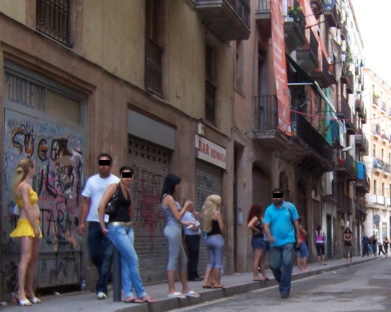
Prostitutes in the streets of Spain
With the example of poverty, earnings and low wages, we can see how women become the victims of both racism and sexism, and how as a consequence African American women are disproportionally affected by poverty, and therefore are the group most likely to get into prostitution because of economic necessity (Monroe, 2005). Other than the factors pushing women into poverty and therefore, into prostitution we have to consider the consequences and laws against prostitution. We can distinguish laws punishing 3 groups: the prostitutes, those who manage prostitution (e.g. the pimp) and those who buy sex (e.g. the customer, also called “John”) (Monroe, 2005). The author notes that out of all these categories the laws punishing the prostitutes are enforced the most, and within that group street prostitutes, disproportionately represented by African American Women, are punished most frequently. Other than legal consequences, street prostitutes also experience violence, stigmatization within society and even death, which often remain unreported. Moreover it is stated in the article that the attempts to fight prostitution are usually focused on the supply side (the prostitutes) rather than the demand side (the “Johns”).
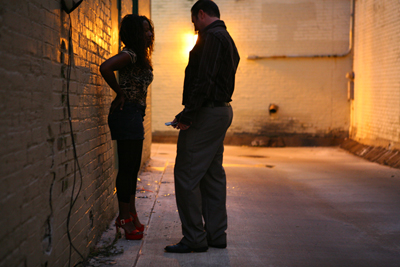
“John” buying sex
The article recalls two legal cases in which the women charged for prostitution challenged the laws by calling them unconstitutional, as they did not treat both sexes equally. Even though decades have passed since those laws were changed, it seems that the law is still discriminatory against women and the sex worker. A vivid example of that is the existence of “John” schools, weekend programs available for first time sex-buyers that they can attend instead of being criminally charged. There are no such programs for sex-workers, who are always processed fully through the criminal system. Nevertheless, Monroe in her article mentions many ways we can try and change the situation, such as: making the minimum wage a living wage, narrowing the pay gap between men and women, endorsing social aid and anti-poverty programs, making the laws towards pimps and panderers more serious, fighting racial and sex discrimination on job selection and penalizing organizations who discriminate.
It seems like the society of North America does not comprehend what the reality of street prostitution is.

Still from “Pretty Woman”, Julia Roberts in the beginning of the plot, still as a prostitute
With movies like “Pretty Woman” (Marshall & Lawton, 1990), a story about a prostitute becomes a fairytale-like romantic comedy, rather than a heart-breaking drama which would be a more adequate description.
The main character Vivian falls in love with a rich businessman who takes her off the streets and they live happily ever after. Although a happy ending would be something that I would very much like to see in a movie about prostitution, it seems like social programs helping the prostitutes to acquire marketable skills would be more beneficial for the whole group (rather than an unlikely and a very unique outcome for just one individual).

Still from further part of “Pretty Woman”, where Vivian starts becoming a princess rather than a sex worker
A Polish novel “Lalka” (Prus, 1890) shows an example of such help towards sex workers, that could be issued by the government as a social program; the main character helps a young prostitute by paying back her debts, putting her into sewing school and afterwards, getting her a job and accommodation. These acts not only take the girl off the streets, but also give her the means to start a different lifestyle.
An example of a realistic portrayal of prostitution is the Spanish movie “Princesas” (Aranoa, 2005), to which we can apply the Africana Womanist perspective.  The plot evolves around two women working as prostitutes: a native Spanish Caye, and an immigrant from Dominican Republic Zulema. From the moment they meet it is clear that even though they work in the same profession, Zulema as a Black woman is much more effected by the associated risks and dangers. For papers such as work permit she is forced to have sex with a violent and dangerous man who beats her when she says no, and as an illegal immigrant she cannot press charger and thus is not protected by the law in any way. She can barely afford a small room that she rents out for half of a day and shares with a family he mistreats her because of her profession. Her actions are a result of economic necessity as she support her family living in Dominican Republic financially. When she is found badly beaten by the same man in a hotel room, the stuff twos her out and threatens to call police on her, instead of helping her by getting medical help that she clearly needs.
The plot evolves around two women working as prostitutes: a native Spanish Caye, and an immigrant from Dominican Republic Zulema. From the moment they meet it is clear that even though they work in the same profession, Zulema as a Black woman is much more effected by the associated risks and dangers. For papers such as work permit she is forced to have sex with a violent and dangerous man who beats her when she says no, and as an illegal immigrant she cannot press charger and thus is not protected by the law in any way. She can barely afford a small room that she rents out for half of a day and shares with a family he mistreats her because of her profession. Her actions are a result of economic necessity as she support her family living in Dominican Republic financially. When she is found badly beaten by the same man in a hotel room, the stuff twos her out and threatens to call police on her, instead of helping her by getting medical help that she clearly needs.

Still from “Princesas”, showing street prostitutes trying to catch customers’ attention
Meanwhile Caye can afford a nice apartment, has a network of clients that allows her to stay off the streets and gets to see her family everyday. Both women experience sexual assault and violence due to men not respecting their boundaries and objectifying them just because of what their job is. Both face being ostracized, ridiculed and offended. Not to mention the psychological impact the job has on Caye and Zulema, turning the intimate act of sex into something difficult to enjoy, as it begins being associated with something unpleasant and brings the feelings of regret and resentment. Another example that we can understand better using the Africana Womanist perspective is when the Spanish prostitutes call the police on the Black sex workers, because “they steal their jobs”.

Caye and Zulema, heroines of “Princesas”
We can see how not only prostitutes are ostracized in a society, but also how Black women are ostracized within that group. The movie shows many, often not spoken about, aspects of street prostitution and gives examples on how it affects the lives of the workers, such as venereal diseases, violence and stigmatization. It is an honest portrayal of the brutal reality of street prostitution, and how Black Women are somehow affected by it disproportionally more.
In the article “Modern day slavery: poverty and child trafficking in Nigeria” (Adesina, 2013) the author explores how poverty and trafficking correlates. Human trafficking is defined by Adesina as a process of recruiting people in their country or community and transporting them into a destination of exploitation in the forms such as forced labour, prostitution or domestic servitude; a modern day slavery.
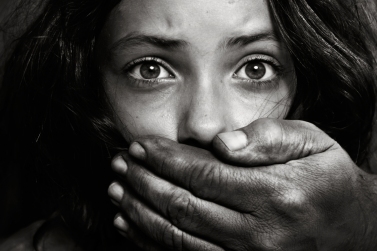
Child-trafficking victim portrayal
It is stated that human trafficking can take internal (within a country) and external (out of a country) forms, like in closely examined by Adesina Nigeria, in which all of the forms occur. The children who are victims of trafficking not only suffer from poor conditions, exploitation and abuse; the experience also affects their future, as they get used to performing criminal activities, suffer psychologically and don’t get education or training that would help them get employment later in life. Adesina (2013) sees the link between how big the child trafficking business is in Nigeria and how high (about 70% of the population) the poverty in the country is. Poverty, in the article, is defined as a lack of resources needed to accommodate basic human needs. The rise of the laws in Nigeria protecting the victims and prohibiting human trafficking has resulted in an increase of rescued victims. The study introduced in the article sheds some light on child trafficking an provided new insight. What seems surprising is that the traffickers are usually extended relatives of the victim or someone well-known in their community and the majority of them are women, as they are believed to be more trust-worthy.
Both articles identify poverty as the root of the problems described, child-trafficking and prostitution. Most women go into prostitution out of economic necessity, and most children that are victims of trafficking come from poor families. It is lack of economic opportunities that pushes people into this “work”. Other factors contributing are lack of education and other job prospects or coming from a large family (all common consequences of poverty) and additionally sex, as women are highly more likely to be victims of trafficking or to become a sex worker. Just as prostitutes, victims of child-trafficking suffer psychological damage that impacts them in the future, as a result of not only the exploitation, but also sexual assaults or negative treatment from society or “clients”. Both Monroe and Adesina recognize that the first step in fighting the issues is collecting more data, adjusting the government laws and policies and stricter prosecution of offenders (in the case of prostitution sex worker should be perceived more as the victim and the laws should be more strict towards the client).
Some may argue that child-trafficking and prostitution involve only a margin of society, people from the poorest, less advanced countries, rural areas or the ones living in extreme poverty; and therefore they can try to make an argument that the sexism represented in these phenomenas is not an accurate description of a modern Western society. Well, how will the privileged clearly remaining oblivious to the fact that child-trafficking and prostitution are problems of ALL of us explain the gender dynamics in the Western media?
In the article “Mediated football: representations and audience receptions of race/ethnicity, gender and nation” Spaaij and van Serkenburg (2015) attempt to analyze the representation, audience reception and media content of mediated football. The authors call media sport omnipresent, especially men’s soccer, as the games are capable of attracting more viewers at the same time than any other media genre (2015). They believe that they are more than just sport events, as they have become influential media spectacles, which gives football celebrities a platform to become role models. Many of them use it for good cause, such as social campaigns fighting racism, like the nike campaign. However it is noted that football can also disadvantage minority groups and contribute to increasing discrimination, as many hooligans attending the games use it as a platform to chant racial slurs and showcase offensive banners. In his article “The racism aimed at Mario Balotelli and Kevin-Prince Boateng shames Italy” Bandini notes that there is not much players such as Zoro or Balotelli can do, as abandoning the game would be equal to loosing; and therefore it is the responsibility of those with more power, like FIFA to fight the racism.

Zora taking the ball and walking off the field after hearing racist chants
Even the media is at fault of bias and stereotypical portrayal of races, such as attributing superhuman power to the Blacks or irrationality to Muslims. Women are not only victims of stereotyping, but also trivializing and under-representation. Their success is usually attributed to their male couches or father figures, and they often are portrayed as sexualized objects. Not only do they have to be excellent players, they are also expected to be attractive and feminine at all times. Women sports receive much less coverage in the media and by the audience are considered something of the lesser value. We can see how applying feminist perspective to football exposes racism and sexism in the media representation.
In the article “‘Race’, Gender and Neoliberalism: changing visual representations in development” Kalpana Wilson (2011) argues that even when the problem of under-representation is solved, another issue is misrepresentation. The author states that women should be not portrayed as victims that need to be rescued from their current situation (like oppression they experience from their husbands or societies) (Wilson, 2011). Women living in developing countries or poverty are objects of “instrumentalisation” as their portrayal contributes to “feminisation of responsibility”, as they sacrifice themselves for the good of their children, and thus the children become mainly their responsibility.
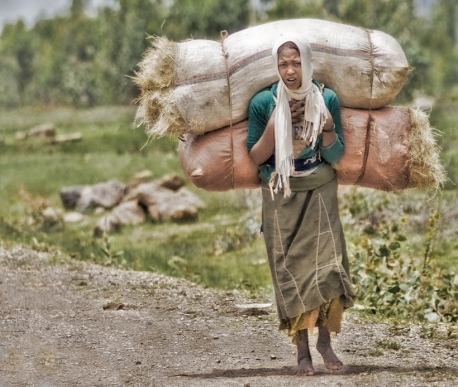
A Third World country Woman portrayed as a hard worker, contributing to her community
Western women are portrayed as liberated, in control and an ideal that all societies should aim to match. Wilson notes how in the past media chose to focus on “negative” images portraying the Third World countries as helpless victims needing help from the developed West. With the shift of focus to “positive” images showing women as active and productive agents, an “investment” for Western donors, men are portrayed as oppressors not contributing to their families or communities. We are also given an example in which such positively represented African Woman is a subject of sexualization with the purpose of selling something to Western consumers. Consequently we need to consciously aim to not only portray Women of developing country as more than just victims; we should not use them as advertisement or a mean of making Western societies feel better about themselves, as the West is shown as the ideal the Third World countries should thrive to be like.
As you can see, not only does the feminist perspective provide additional insights to issues our society faces; it is crucial to determining the underlying cause and looking for a solution. The Africana Womanist perspective explains how our society’s dynamic makes Black Women most affected by poverty, and therefore the group most likely to enter the prostitution business. Looking at child trafficking also requires as to use intersectional feminism perspective to truly understand the phenomenon. Moreover, feminism is useful even in analyzing things that some might find easier to relate, such as media representation, as we can see on the examples of how football or women from Third World countries are portrayed in Western Media.
Sources:
-
J. Monroe PhD (2005), “Women in Street Prostitution: The Result of Poverty and the Brunt of Inequity”, Journal of Poverty, 9:3, 69-88, DOI: 10.1300/J134v09n03_04
P. S. Rothenberg (1995), “Race, class, and gender in the United States: An integrated study” (3rd ed.), New York: St. Martin’s Press.
J. van Sterkenburg & R. Spaaij (2015), “Mediated football: representations and audience receptions of race/ethnicity, gender and nation”, Soccer & Society
K. Wilson (2011), “‘Race’, Gender and Neoliberalism: changing visual representations in development”, Third World Quarterly
P. Bandini (2013), “The racism aimed at Mario Balotelli and Kevin-Prince Boating shames Italy”, The Guardian
Images retrieved from:
- https://www.moviefone.com/movie/princesas/20019417/main/
- http://way2enjoy.com/forums/viewthread/1959866/simon_nessman_photos_by_way2enjoycom_simon_nessman_latest_news_photos_biography_videos_and_wallpapers
- https://onedayasaprostitute.wordpress.com/2015/04/23/princesas-2005/
- http://mkenyaujerumani.de/2014/02/21/when-black-women-in-europe-are-assumed-to-be-hookers/https://prezi.com/qe2fiylwx0v_/el-raval/
- http://www.neontommy.com/news/2014/02/children-recovered-sex-trafficking-super-bowl
- http://www.telegraph.co.uk/women/11814496/Prostitutes-in-hi-vis-put-to-death-the-Pretty-Woman-myth.html
- http://acculturated.com/no-pretty-woman-is-not-pro-prostitution/
- http://borgenproject.org/causes-of-human-trafficking/
- http://marcelloscotti-bcn.blogspot.ca/2012/02/life-in-ethiopia-as-usual-in-third.html
- http://edition.cnn.com/2008/SPORT/football/06/18/racism.europe/index.html?eref=rss_latest
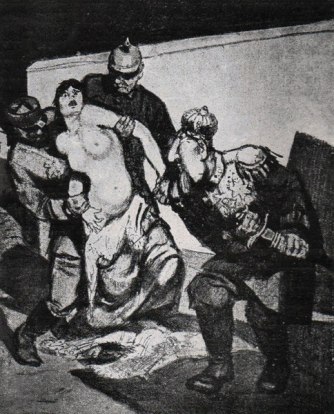
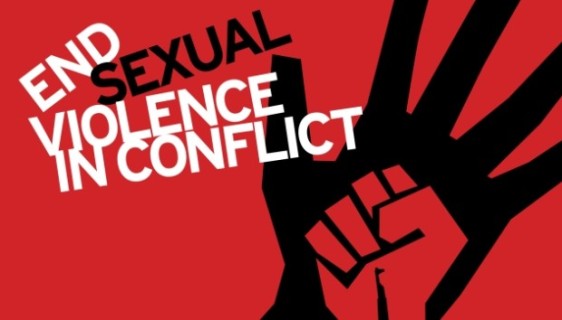
 Throughout life if we are conscious or observant enough we will notice the countless ways that heteronormativity affects our lives. A very common and seemingly harmless way is the one I addressed in this post’s title – questions with which we follow the information about someone’s sexual orientation. If you are a heterosexual woman, it is very unlikely that someone will ask you: “So when did you know you liked guys?”. The reason for this is that heterosexuality is perceived as the norm in our society. When people find out that I am bisexual, they often ask a similar question: “So when did you know you liked girls?”. Whenever I hear that, I answer: “I never thought I was heterosexual”. Many people, just like me, don’t have an amusing story about how they suspected that they were not “normal” because they were attracted to the same sex in middle school. If we use the sociological perspective, we can see how heteronormativity affects not only individuals, but society as a whole. One of the harmful ways that it does that is how sexuality education is being taught in our school.
Throughout life if we are conscious or observant enough we will notice the countless ways that heteronormativity affects our lives. A very common and seemingly harmless way is the one I addressed in this post’s title – questions with which we follow the information about someone’s sexual orientation. If you are a heterosexual woman, it is very unlikely that someone will ask you: “So when did you know you liked guys?”. The reason for this is that heterosexuality is perceived as the norm in our society. When people find out that I am bisexual, they often ask a similar question: “So when did you know you liked girls?”. Whenever I hear that, I answer: “I never thought I was heterosexual”. Many people, just like me, don’t have an amusing story about how they suspected that they were not “normal” because they were attracted to the same sex in middle school. If we use the sociological perspective, we can see how heteronormativity affects not only individuals, but society as a whole. One of the harmful ways that it does that is how sexuality education is being taught in our school.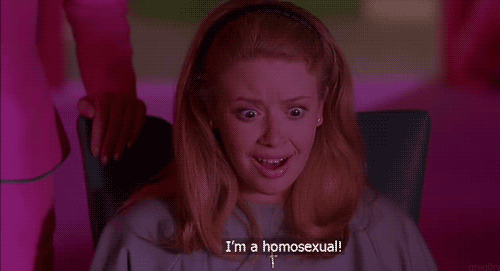
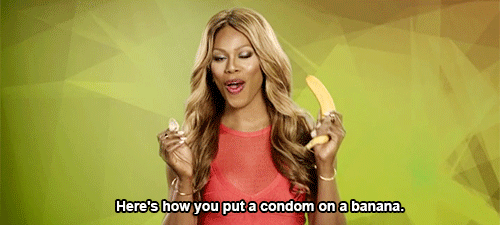
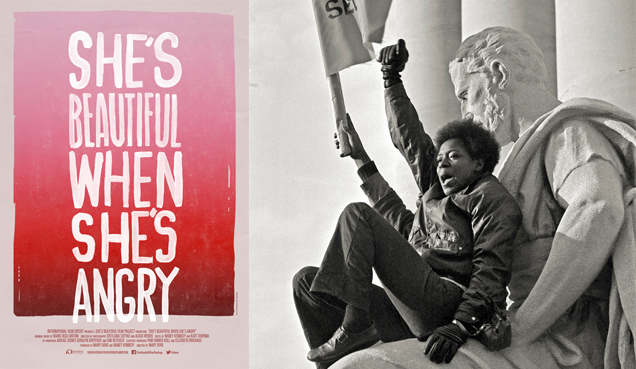
 “As I see it, feminism’s ambivalence has been resolved in recent years in favour of the second, liberal-individualist scenario – but not because we were passive victims of neoliberal seductions. On the contrary, we ourselves contributed three important ideas to this
“As I see it, feminism’s ambivalence has been resolved in recent years in favour of the second, liberal-individualist scenario – but not because we were passive victims of neoliberal seductions. On the contrary, we ourselves contributed three important ideas to this